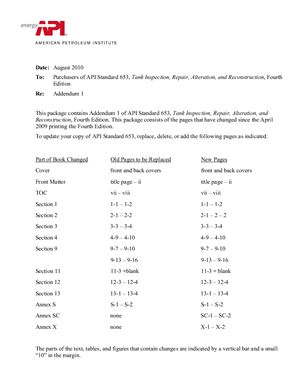44 стр.
FOURTH EDITION, APRIL 2009
ADDENDUM 1, AUGUST 2010
This standard covers steel storage tanks built to API 650 and its predecessor API 12C. It provides minimum requirements for maintaining the integrity of such tanks after they have been placed in service and addresses inspection, repair, alteration, relocation, and reconstruction.
The scope is limited to the tank foundation, bottom, shell, structure, roof, attached appurtenances, and nozzles to the face of the first flange, first threaded joint, or first welding-end connection. Many of the design, welding, examination, and material requirements of API 650 can be applied in the maintenance inspection, rating, repair, and alteration of in-service tanks. In the case of apparent conflicts between the requirements of this standard and API 650 or its predecessor API 12C, this standard shall gove for tanks that have been placed in service.
This standard employs the principles of API 650; however, storage tank owner/operators, based on consideration of specific construction and operating details, may apply this standard to any steel tank constructed in accordance with a tank specification.
This standard is intended for use by organizations that maintain or have access to engineering and inspection personnel technically trained and experienced in tank design, fabrication, repair, construction, and inspection.
This standard does not contain rules or guidelines to cover all the varied conditions which may occur in an existing tank. When design and construction details are not given, and are not available in the as-built standard, details that will provide a level of integrity equal to the level provided by the current edition of API 650 must be used.
This standard recognizes fitness-for-service assessment concepts for evaluating in-service degradation of pressure containing components. API 579-1 /ASME FFS-1, Fitness-For-Service, provides detailed assessment procedures or acceptance criteria for specific types of degradation referenced in this standard. When this standard does not provide specific evaluation procedures or acceptance criteria for a specific type of degradation or when this standard explicitly allows the use of fitness-for-service criteria, API 579-1/ASME FFS-1 may be used to evaluate the various types of degradation or test requirements addressed in this standard.
FOURTH EDITION, APRIL 2009
ADDENDUM 1, AUGUST 2010
This standard covers steel storage tanks built to API 650 and its predecessor API 12C. It provides minimum requirements for maintaining the integrity of such tanks after they have been placed in service and addresses inspection, repair, alteration, relocation, and reconstruction.
The scope is limited to the tank foundation, bottom, shell, structure, roof, attached appurtenances, and nozzles to the face of the first flange, first threaded joint, or first welding-end connection. Many of the design, welding, examination, and material requirements of API 650 can be applied in the maintenance inspection, rating, repair, and alteration of in-service tanks. In the case of apparent conflicts between the requirements of this standard and API 650 or its predecessor API 12C, this standard shall gove for tanks that have been placed in service.
This standard employs the principles of API 650; however, storage tank owner/operators, based on consideration of specific construction and operating details, may apply this standard to any steel tank constructed in accordance with a tank specification.
This standard is intended for use by organizations that maintain or have access to engineering and inspection personnel technically trained and experienced in tank design, fabrication, repair, construction, and inspection.
This standard does not contain rules or guidelines to cover all the varied conditions which may occur in an existing tank. When design and construction details are not given, and are not available in the as-built standard, details that will provide a level of integrity equal to the level provided by the current edition of API 650 must be used.
This standard recognizes fitness-for-service assessment concepts for evaluating in-service degradation of pressure containing components. API 579-1 /ASME FFS-1, Fitness-For-Service, provides detailed assessment procedures or acceptance criteria for specific types of degradation referenced in this standard. When this standard does not provide specific evaluation procedures or acceptance criteria for a specific type of degradation or when this standard explicitly allows the use of fitness-for-service criteria, API 579-1/ASME FFS-1 may be used to evaluate the various types of degradation or test requirements addressed in this standard.

